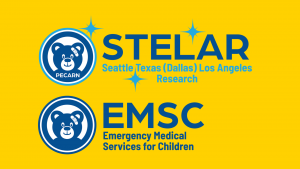Authors: Tim Montrief (@EMinMiami, EM Resident Physician, Jackson Memorial Health System) // Edited by: Alex Koyfman, MD (@EMHighAK) and Brit Long, MD (@long_brit)
Case
A 37-year-old woman with a past medical history of systemic lupus erythematous presents to the emergency department with a chief complaint of hemoptysis, and she states she has been feeling dyspneic for the past three days, with decreased urine output. She is tachycardic, tachypneic, normotensive and oxygenating 92% on room air. Labs reveal thrombocytopenia and hemolytic anemia…
Questions
What is catastrophic antiphospholipid syndrome (CAPS), and how does it differ from antiphospholipid syndrome? What is the pathogenesis of CAPS?
What are risk factors for developing CAPS? What is the clinical presentation of a patient with CAPS?
What are the necessary lab tests and imaging to evaluate for suspected CAPS?
What is the initial management of a patient with CAPS? What is the prognosis of a patient with CAPS?
When should the emergency physician consider CAPS as a diagnosis? What are the challenges to diagnosing CAPS in the emergency department?
Background
- Antiphospholipid antibody syndrome (APS) is a multisystem autoimmune condition characterized by:1
- Vascular thromboses and/or pregnancy loss associated with persistently positive antiphospholipid antibodies
- Lupus anticoagulant
- Anticardiolipin antibody
- Anti-β2-glycoprotein-I antibody
- Catastrophic antiphospholipid antibody syndrome is a rare (<1% prevalence in all APS patients) life-threatening form of APS in which widespread intravascular thrombosis results in multi-organ ischemia and failure over a short period of time.1,2
- CAPS is characterized by intravascular thrombosis predominantly affecting the microcirculation.
- Thrombosis of arteries, veins, or both can occur.3
- Diagnostic criteria for CAPS include:4
- Involvement of three or more organs/tissues.
- Development of manifestations in less than a week.
- Histological evidence of intravascular thrombosis:
- Can include congestion, microthrombi, and positive immunostaining for fibrin.5
- Presence of antiphospholipid antibodies.
- A definite diagnosis of CAPS requires all four of the above criteria to be met. A diagnosis of CAPS is probable if three of the criteria are met.
- The pathogenic mechanisms behind antiphospholipid antibodies can be subdivided into four categories:2-4
- Cellular activation
- Antiphospholipid antibodies can stimulate endothelial cells, immune cells, and platelets, promoting a pro-inflammatory and pro-thrombotic state.
- Antiphospholipid antibodies decrease endothelial nitric oxide production causing impaired vasodilation that promotes platelet adhesion to the endothelium.
- Inhibition of anticoagulants
- Antiphospholipid antibodies can inhibit anticoagulants including protein C, protein S, and antithrombin.
- Inhibition of fibrinolysis
- Antiphospholipid antibodies inhibit tPA and block β2-glycoprotein-I.
- Complement activation
- Cellular activation
- Vascular thromboses and/or pregnancy loss associated with persistently positive antiphospholipid antibodies
Clinical Manifestations
- The currently accepted hypothesis is that CAPS occurs in genetically susceptible individuals in response to an environmental trigger.4
- Precipitating factors are known in roughly 62% of patients with CAPS:4-7
- Infection (22%)
- Surgery (10%)
- Oral anticoagulant withdrawal/low INR (8%)
- Medications (7%)
- Obstetric complications (7%)
- Neoplastic disease (5%)
- Systemic lupus erythematous flare (3%)
- Idiopathic (38%)
- CAPS, much like APS, has a stronger pre-disposition for women, who make up 69% of CAPS patients.4
- Most patients have a previous diagnosis of an auto-immune disease, although CAPS can be the initial presentation in some cases:4
- Antiphospholipid syndrome (56%)
- SLE (28%)
- Unspecified autoimmune disease (8%)
- SLE-like disease (3%)
- Rheumatoid arthritis (1%)
- CAPS presentations vary, as its microvascular thrombosis can affect any organ. Clinical signs and symptoms of CAPS include:4-8
- Neurological involvement (20%)
- Encephalopathy
- Cerebrovascular accidents
- Seizures
- Headache
- Pulmonary involvement (14%)
- Acute respiratory distress syndrome (ARDS)
- Pulmonary embolism
- Intra-alveolar hemorrhage
- Renal involvement (13%)
- Acute kidney injury
- Renal infarction
- Cutaneous involvement (11%)
- Livedo reticularis
- Leg ulcers and necrotic lesions
- Digital gangrene and splinter hemorrhages
- Purpura and multiple ecchymosis
- Deep venous thrombosis
- Peripheral arterial occlusive disease
- Cardiac involvement (6%)
- Cardiac failure
- Myocardial infarction
- Valvular lesions
- Multi-organ involvement (7%)
- Retinal involvement (7%)
- Bone marrow necrosis (4%)
- Neurological involvement (20%)
Workup and Management
- CAPS presentations vary, and symptoms will guide the necessary labs and imaging.
- It is necessary to investigate for end-organ dysfunction through laboratory tests or imaging.7
- Lab abnormalities in CAPS include:4
- Thrombocytopenia (46%)
- Patients with thrombocytopenia are more likely to develop hemolysis, schistocytes, disseminated intravascular coagulation (DIC), and high fibrin degradation products.9
- Thrombotic microangiopathic hemolytic anemia (35%)
- Disseminated intravascular coagulation (DIC) (33%)
- Anti-cardiolipin antibodies (83%)
- Lupus anticoagulant (82%)
- Antinuclear antibodies (66%)
- Elevated acute-phase reactants (unknown %)
- ESR, CRP, serum amyloid A, ferritin
- Management focuses on the identification and treatment of the precipitating factor, treating acute manifestations, and continuing with supportive measures.
- This may include hemodialysis, mechanical ventilation, inotropic drugs, and possibly amputation and debridement of any necrotic tissue as necessary.
- The mortality of CAPS is high, but has improved in recent years (survival now 63%).10
- The acute treatment of CAPS is directed at two different points: the thrombotic events and the suppression of the cytokine cascade.4,11-13
- Thrombotic events
- Anticoagulation with heparin is the mainstay of treatment.
- Warfarin or Direct-Acting Oral Anticoagulants (DOACS) may be used as well.
- Anti-platelet agents may be added.
- Cytokine cascade
- Steroids
- Recommended dose is 1,000 mg/day of methylprednisolone for 3 to 5 days
- Intravenous immunoglobulin
- Recommended dose is 0.4 g/d/kg for 5 days
- Plasma exchange
- Other immunosuppressant medications have been used, including:
- Cyclophosphamide
- Azathioprine
- Cyclosporine
- Mofetil mycophenolate
- Methotrexate
- Rituximab
- Eculizumab
- Steroids
- Thrombotic events
- Thrombocytopenia (46%)
- Triple therapy (anticoagulants + glucocorticoids + plasma exchange and/or intravenous immunoglobulins) is recommended for the management of patients with CAPS.9
- Prognosis for patients with CAPS is generally poor, with an overall fatality rate of 31%.4,7,11,12,14,15
When should the emergency physician consider CAPS? What are the challenges to diagnosing CAPS in the ED?
- Catastrophic antiphospholipid antibody syndrome should be considered as a diagnosis in any patient presenting to the emergency department with an acute (less than one week) presentation of illness involving multiple organ systems, especially neurologic, pulmonary, renal, or cardiovascular.16
- Additionally, patients presenting with an acute thrombotic event with evidence of end-organ dysfunction should prompt evaluation for CAPS and other organ involvement.
- Important questions to evaluate a patient for CAPS include:
- Does the patient have history of APS or persistent positive antiphospholipid antibodies?
- Does the patient have evidence of multiple organ system involvement on physical exam or laboratory findings?
- Does the patient have symptoms developing in less than a week?
- Does the patient have a known precipitating factor for the development of CAPS?
- Does the patient have ‘other explanations’ for multiple organ thromboses and/or microthrombosis?
- However, there are many challenges to diagnosing CAPS in the emergency department:16
- A continuum of thrombotic microangiopathic conditions exists (hemolytic uremic syndrome, HELLP syndrome, Thrombotic thrombocytopenic purpura, DIC) and at times, it may be difficult to differentiate between these conditions due to significant overlapping features.
- When sepsis is associated with DIC, potential complications include bleeding, thrombocytopenia, and microthrombosis, which are common in CAPS patients. Both the pathophysiology and clinical manifestations of CAPS resemble sepsis with the ultimate development of multiple organ dysfunction syndrome.
- A false positive aPL test can be associated with infections and/or anticoagulation.17,18
- Likewise, aPL can rarely become transiently negative at the time of thrombosis possibly because of its consumption.19
- Diagnosis requires confirmation by histopathology of small-vessel occlusion, which is almost never available in the emergency department.
Take Home Points
- Catastrophic antiphospholipid antibody syndrome is a life-threatening form of APS, diagnostic criteria for which includes:
- Involvement of three or more organs/tissues
- Development of manifestations in less than a week
- Histological evidence of intravascular thrombosis
- Presence of antiphospholipid antibodies
- CAPS generally has a precipitating factor, most commonly infection or surgery.
- CAPS can involve any organ system, but most commonly presents with neurologic, pulmonary, renal, or cardiovascular involvement.
- Triple therapy (anticoagulants + glucocorticoids + plasma exchange and/or intravenous immunoglobulins) is recommended for the management of patients with CAPS.
- CAPS should be considered as a diagnosis in any patient presenting to the emergency department with an acute (less than one week) illness involving multiple organ systems, especially neurologic, pulmonary, renal, or cardiovascular.
References / Further Reading
- Cervera R, Piette JC, Font J, Khamashta MA, Shoenfeld Y, Camps MT, et al. Antiphospholipid syndrome: Clinical and immunologic manifestations and patterns of disease expression in a cohort of 1000 patients. Arthritis Rheum. 2002;46:1019–27.
- Miyakis S, Lockshin MD, Atsumi T, et al. International consensus statement on an update of the classification criteria for definite antiphospholipid syndrome (APS). J Thromb Haemost. 2006;4(2):295-306.
- Gómez-Puerta JA, Cervera R. Diagnosis and classification of the antiphospholipid syndrome. J Autoimmun. 2014; 48-49:20-5.
- Nayer A, Ortega LM. Catastrophic antiphospholipid syndrome: a clinical review. J Nephropathol. 2014; 3(1):9-17.
- Cervera R, Bucciarelli S, Plasín MA, Gómez-Puerta JA, Plaza J, Pons-Estel G. et al. Catastrophic antiphospholipid syndrome (CAPS): descriptive analysis of a series of 280 patients from the “CAPS Registry” J Autoimmun. 2009;32(3-4):240–5.
- Rodríguez-Pintó I, Shoenfeld Y, Erkan D, Garriga RE, Cervera R. Catastrophic antiphospholipid syndrome (CAPS): Descriptive analysis of 500 patients from the International CAPS Registry (abstract). Lupus 2016; 25: 12-3.
- Cervera R, Rodríguez I, Espinosa G, Erkan D, Shoenfeld Y. Registry of the “European Forum on Antiphospholipid Antibodies” for patients with the “Catastrophic” Antiphospholipid Syndrome (CAPS Registry). [ONLINE] Available at: https://ontocrf.grupocostaisa.com/es/web/caps/statisticsAccessed 3/24/2018[Accessed 24 March 2018].
- Chinnery PF, Shaw PJ, Ince PG, Jackson GH, Bishop RI. Fulminant encephalopathy due to the catastrophic primary antiphospholipid syndrome. J Neurol Neurosurg Psychiatry 1997; 62: 300-01
- Bayraktar U, Erkan D, Bucciarelli S, Espinosa G, Cervera R, Asherson R. Catastrophic antiphospholipid syndrome (CAPS): comparison between CAPS patients with and without thrombocytopenia. Clin Exp Rheumatol 200; 25: 14.
- Kazzaz NM, Mccune WJ, Knight JS. Treatment of catastrophic antiphospholipid syndrome. Curr Opin Rheumatol. 2016;28(3):218-27.
- Cervera R, Rodríguez-Pintó I, Colafrancesco S, Conti F, Valesini G, Rosário C, et al. 14th International Congress on Antiphospholipid Antibodies Task Force Report on Catastrophic Antiphospholipid Syndrome. Autoimmun Rev 2014; 13:699-707.
- Bucciarelli S, Erkan D, Espinosa G, Cervera R. Catastrophic antiphospholipid syndrome: treatment, prognosis, and the risk of relapse. Clin Rev Allergy Immunol. 2009; 36(2-3):80-4.
- Hughes GR. Hughes syndrome (the antiphospholipid syndrome): ten clinical lessons. Autoimmun Rev 2008; 7:262–6.
- Bucciarelli S, Espinosa G, Cervera R, Erkan D, Gomez-Puerta JA, Ramos-Casals M, et al. Mortality in the catastrophic antiphospholipid syndrome: causes of death and prognostic factors in a series of 250 patients. Arthritis Rheum 2006; 54:2568–76.
- Erkan D, Asherson RA, Espinosa G, Cervera R, Font J, Piette JC, et al. Long term outcome of catastrophic antiphospholipid syndrome survivors. Ann Rheum Dis 2003; 62:530–3.
- Aguiar CL, Erkan D. Catastrophic antiphospholipid syndrome: how to diagnose a rare but highly fatal disease. Ther Adv Musculoskelet Dis. 2013;5(6):305-14.
- Wenzel C, Stoiser B, Locker GJ, et al. Frequent development of lupus anticoagulants in critically ill patients treated under intensive care conditions. Crit Care Med. 2002;30(4):763-70.
- Avcin T, Toplak N. Antiphospholipid antibodies in response to infection. Curr Rheumatol Rep. 2007;9(3):212-8.
- Miret C, Cervera R, Reverter JC, et al. Antiphospholipid syndrome without antiphospholipid antibodies at the time of the thrombotic event: transient ‘seronegative’ antiphospholipid syndrome? Clin Exp Rheumatol. 1997;15(5):541-4.








